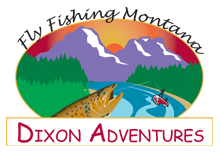Fly Fishing the Clark Fork River
The Clark Fork is approximately 310 miles (500 km) long. The largest river by volume in Montana, it drains an extensive region of the Rocky Mountains in western Montana and northern Idaho in the watershed of the Columbia River, flowing northwest through a long mountain valley and emptying into Lake Pend Oreille in northern Idaho.
With this much water, there is a wide variety of sections to choose from that have their own personality. The Clark Fork River is divided into 2 separate sections, the Upper Clark Fork and The Lower Clark Fork. The Upper Clark Fork has more riffles and holds more Brown Trout than the Lower Clark Fork. Dixon Adventures has over 20 years of experience working on the Clark Fork.
Besides the runoff in June, we fish this river all season. There are great hatches that provide awesome Dry Fly Fishing, and we usually average 16″ rainbow trout, and land a trophy on almost every trip. The size of this river can be intimidating to most, but our guides are experienced on over 150 miles of this river!
The removal of Milltown Dam at the confluence of The Blackfoot and Clark Fork River has us excited about the future. Removing this blockade of almost 100 years has opened up the potential for trout migration and has improved the quality of water.
Dixon Adventures starts fishing the Clark Fork in the spring. Stonefly and mayfly hatches create a great opportunity for some big trout on dry flies. After the run-off in June, The Clark Fork becomes one of our main rivers and we target predominately rainbow and cutthroat trout on dry flies. There are great hatches all summer long and the hopper/attractor fishing in the late summer and fall can be spectacular!
Another feature we offer on our Lower Clark Fork Trips is sight fishing for large Northern Pike. Some of the sloughs have Northern Pike that can be over 15 pounds, and we occasionally put our trout rods down and target these large toothy critters for a liitle variety on our adventures!

